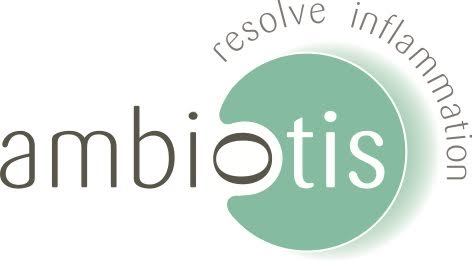Expertise of Ambiotis: Validation of drug efficacy on inflammation from proof of concept at preclinical stage to biomarker monitoring in clinic
Ambiotis is a research-based company specialized in the field of inflammation with a thorough understanding of the resolution phase of this process.
Ambiotis develops validated models and technologies to bring the proofs of concept and decipher mechanisms of action of drug candidates for our business partners and help them to put faster on the market new and innovative anti-inflammatory and pro- resolutive drugs.
Ambiotis has the ability to set up full research programs from screening assays up to monitoring of biomarkers in clinical trials.
How to evaluate anti-inflammatory drugs ?
Inflammation is a natural response of the body to injury or infection. If correctly controlled, it leads to the complete restoration of the targeted tissue.
This return to basal conditions is called resolution and is characterized by the natural and sequential synthesis of specialized pro-resolving mediators (resolvins, protectins, lipoxins, maresins) or SPMs. These mediators are essential to induce correct healing and prevent from fibrosis and chronic inflammation.
SPMs have known biological and beneficial activities in many inflammatory contexts including neurodegenerative diseases, respiratory disorders, infections...
Current therapeutic molecules attempt to inhibit pathways leading to the production of pro-inflammatory mediators. Continuous characterization of resolution process is considerably changing the vision of drug development. It may indeed be possible to consider the development of agonists of resolution pathways to fight chronic inflammation.
In addition, incorporate the evaluation of activities on resolution of anti-inflammatory drugs will also be necessary to avoid a resolution-toxic behaviour.
Ambiotis has developed a step-by-step approach on anti-inflammation and/or pro-resolution strategies
Any step can also be performed on its own.
- in vitro screening of drug potential (secretory and functional approaches in human primary cells)
- in vivo proof-of- concept. Use of very well characterized and reference models in the field. Our models allow the understanding of the physiological response to a drug and quantification of beneficial effects thanks to the calculation of resolution indices...
- In disease models and/or human monitoring of resolution mediators
- translational approaches
- disease biomarker monitoring
- efficacy biomarker monitoring
From screening to physiology
Bioavailability validation
- Monitoring in animal models of drug availability in blood or tissues
Safety assessment
- Immuno-toxicity evaluation in whole blood
In vitro and in vivo efficacy screening
- Immuno-stimulation/immuno- modulation to various stimuli
- Anti-inflammatory properties
- Pro-resolutive properties
- Modulation of functional capacities (macrophage polarization state, phagocytosis, oxidative burst activity, cell differentiation...)
Efficacy validation
- Animal models of inflammation in numerous therapeutic areas
- comparison to a reference molecule
- physiological, clinical and blood parameters
- tissue and cell analysis (histology and cytometry)
- cell function (mediator secretion …)
- gene expression
- Clinical trials in humans: mediator monitoring in blood, urine or tissues
In vitro models : human primary cell models
- Whole blood
- PBMCs
- Monocytes
- Dendritic cells
- Macrophages (M1, M2, foamy…)
- Neutrophils
- Lymphocytes and Mixed Lymphocyte Reaction (MLR)
- Pre-adipocytes and adipocytes
- Keratinocytes
- Fibroblasts
- Melanocytes
- Co-culture
- Reconstructed human skin
- Skin explant
Cells can also be extracted from animals and further manipulated in ex vivo experiments
In vivo models
Autoimmune disease and articulation
- Collagen-induced arthritis
- Carrageenan-induced paw oedema
- Air pouch
- mBSA-induced arthritis
- MSU-induced gout
Respiratory diseases
- Elastase-induced emphysemal
- LPS lung challenge
Allergy
- Ovalbumin-induced allergic asthma
- Food allergy (OVA, BLG, PE)
- Atopic dermatitis
- Anaphylaxis: PSA/PCA ; PSA induced in humanized IgE/FcεR1 mice from genOway
Intestinal bowel diseases
- DSS-induced colitis
- TNBS-induced colitis
- Ischemia/reperfusion
Obesity/diabetes
- HFD induced obesity
- Genetic : Ob/Ob and Db/Db
Fibrosis
- Bleomycin-induced lung fibrosis
- CCl4-induced liver fibrosis
Infectious diseases
- Sepsis (CLP, cecal slurry CS)
- Other in collaboration
Peritonitis
- Zymosan-induced peritonitis
- Thioglycollate-induced peritonitis
- other peritonitis
Cells can also be extracted from animals and further manipulated in ex vivo experiments
Analytical services
Lipid analysis
- Eicosanoids (Inflammatory mediators, SPMs)
- Endocannabinoids
- Fatty acids (saturated, mono/poly-unsaturated …) : DHA, EPA, ARA, omega-3 index, sapienic acid, sebaleic acid…
- Cholesterol, sterols, triglycerides
- Squalene
Techniques: LC-MS/MS ou GC-FID
Cytokine and chemokines
- Inflammatory cytokines and chemokines
- Anti-inflammatory cytokines
Techniques: ELISA, Milliplex, Flow cytometry
Gene expression
- Single gene expression
- Profiling using microfluidic dynamic array
Techniques: RT-qPCR
Oxidative stress markers
- Reactive oxygen species
Techniques: Luminometry (real-time assays), Flow cytometry (accumulation), fluorometry, mass spectrometry
Cells and Tissues
Techniques: Flow cytometry, Histology
Ways of working with us
Step 1: your need
- Understanding of your need
- Orientation toward the relevant work package
- analytical package : provide us with samples to be analyzed
- model-based package : provide us with your compounds to evaluate
- Customized development
- Scientific consulting
Step 2: our collaboration
- Performance of services according milestones and go/no go steps
- Regular follow-up
Step 3: your results
- Scientific feedback through webex conference
- Final report
- Follow up



